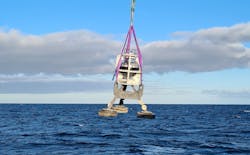Sensors measure subsidence at Ormen Lange field offshore mid-Norway
Offshore staff
YATELEY, UK – Sonardyne will deploy underwater sensors for a seabed monitoring project at Norske Shell’s Ormen Lange gas/condensate field in the Norwegian Sea.
The company will supply more than 20 Fetch Ambient-Zero-Ambient (AZA) pressure monitoring transponders (PMTs) for the campaign.
Unlike traditional pressure sensors, which according to Sonardyne suffer from drift over time, the AZA systems are designed to autonomously re-calibrate in situ.
Periodically, a control system cycles the pressure sensor from ambient seabed pressure to near-zero, enabling comparison with an accurate low-pressure reference sensor for calibration.
The reference sensor is not subjected to ambient pressure and is said to be accurate to changes of less than 1 millibar, or around 1 cm of head of water.
In-situ calibration, the company adds, provides the capability to monitor seafloor subsidence with centimetric accuracy for up to 10 years, without the need for retrieval and recalibration of the sensors.
This is the latest deployment of Fetch PMTs at Ormen Lange, 120 km (75 mi) offshore, in 800-1,100 m (2,624-3,609 ft) water depth. Each sensor collects pressure, temperature, and inclination data at the seafloor, at pre-programmed intervals.
Data are then taken from a high-speed acoustic modem within each Fetch PMT or Fetch AZA PMT, using acoustic systems deployed from an unmanned surface vehicle or conventional vessel.
The data is used to calculate any vertical displacement of the seabed at the field location.
Shaun Dunn, vice president of Projects at Sonardyne, said: “Many years ago, geophysicists at Shell set Sonardyne the challenge of creating instruments that were sensitive enough to measure 1 cm/year of vertical movement.
“With this latest generation of Fetch AZA, we have achieved that goal and unlocked the benefits of using this technology to detect extremely low levels of seafloor subsidence as part of proactive reservoir management programs.”
03/09/2021
